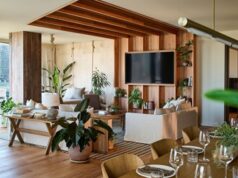
Every time an article comes out touting the “green” countertop options available on the market, it is woefully inaccurate. Often listing the same material multiple times in different formats, or completely misunderstanding the green claims of others, the lists just don’t stand up to reality.
So here is a real list of the countertop options and the manufacturers whose true mission and goal is to create healthier surfaces, more durable surfaces, and divert waste from the oceans and landfills, creating something beautiful that you can feel good about. Why not have your surface tell a story of its own? And one that you can be proud to share?
PaperStone—recycled paper and petroleum free resin. Comparable to steel in its strength, PaperStone is one of the most unique surfacing options out there. Diverting millions of pounds of paper from landfill, this versatile material comes in multiple sizes and thicknesses, so it can be optimized for your project. It can be cut on site and is a DIY or remodeler’s ideal material. It is easily cut with woodworking tools but holds up like stone. A matte, organic finish makes it a natural choice and great alternative to glossy stone finishes.
IceStone—recycled glass and concrete. As you toss that wine bottle into the recycling bin, you know that its destination could very well be in someone else’s kitchen as a countertop. Hundreds of thousands of pounds of glass have been diverted from landfills, and, combined with concrete, and often mother-of-pearl, to create stunning IceStone slabs. IceStone is 75 percent recycled glass by weight and is manufactured in Brooklyn, N.Y. It is Cradle to Cradle certified, and is a Certified B Corp.
Other Brands: Vetrazzo, Merge Design.
Durat solid surface—recycled solid surface. Plastic piling up? Durat is designed in Europe, but also manufactured in the United States. With up to 28 percent recycled content, over 200 tons of plastic have been diverted from the waste stream and repurposed into this bright, sleek solid surface. Boasting an aesthetic unmatched by other solid surface providers, Durat is unique in its mission to bring Europe’s passion for protecting the environment to the United States.
Lapitec Sintered Stone—man-made volcanic slabs. Have to replace a stained or scratched surface? Sintered stone is hot on the heels of quartz. And we say hot because that is how the slabs are formed. Heat and pressure fuse the minerals into a completely impermeable surface and has integrated technology that kills harmful bacteria on the surface. Unable to be etched or scratched, this is the surface that will last forever. It also cleans the air. Yes, that is right—it has an integrated titanium dioxide technology that breaks down pollutants. Its use in the home is a no-brainer but as exterior cladding, it is going to help change the planet.
eco by Cosentino—recycled glass and resin. What is the eco-friendliest quartz? Available in big box stores, eco by Cosentino is the company’s contribution to diverting waste, but Cosentino still pushes its primary line of non-recycled quartz. However, eco by Cosentino is 75 percent recycled content and includes materials such as mirror, glass, porcelain, earthenware and vitrified ash. So, if you want something that looks like quartz, but has a better story, this is a good option.
GEOS—recycled glass and resin. Also available in big box stores, recycled glass and resin surfaces like GEOS offer a more durable surface than some of the concrete options, but tend to lack the depth that the concrete based surfaces have, because they typically use petroleum-based, or epoxy resins. A trade-off, though, is that the glass is still recycled and is not ending up in the landfill.
Other Brands: Glass Recycled Surface, Gilasi, Grenite, Curava.
TorZo—infused wood-based acrylic panels. TorZo surfaces are ideal for vanity tops or table tops as they take wood or fiber-based materials that would otherwise be left behind and integrates an acrylic technology to make them 10 times harder. Materials like Sorghum board and Blue Stain Pine, often left as post-industrial refuse are revived into stunning surfacing materials, and still maintain the organic look of a wood based, natural product. TorZo is also made in the United States.
Alkemi—recycled metal shavings in polyester. Alkemi has been repurposing metal shavings into a clear resin for a very recycled look that showcases the metal shavings and really tell the tale of a recycled product. On the market for nearly two decades, Alkemi continues to carve out a niche as a durable table top and vanity surface.
Reclaimed Wood—repurposed woods from some other use. Using reclaimed woods for surfacing is a great idea if you don’t mind your counters “wearing in.” If, from the outset, you accept the limitations of wood, this is a great option for a natural, organic surface that has a great story.
Bamboo—fast growing, easily regenerated. If you find a viable supplier like Plyboo, ecoFusion or Kirei, bamboo can be a great surfacing option, as it is strong and economical. Easily cut with woodworking tools, this makes a great vanity top or table top material. Like wood, it can be finished and will wear like wood over time, though it is harder than many hardwoods. There are also a lot more color options and the strand products allow for less of that striated look that makes it look too “bamboo-like” if you don’t want that aesthetic.
There are likely some other options as well, but this is a good starting point for pulling together a true list of surfacing manufacturers that go beyond the story and truly have a mission of making the world a better and healthier place.
Do you have a story about your countertop and what it means to you? We want to hear it!
Jessica McNaughton is President, CaraGreen. She has 20+ years of strategic sales and marketing experience including researching and successfully launching new product campaigns, identifying and integrating wholesale partners, and partnering with architects and designers to find the right solution (even when it’s outside CaraGreen’s product offering). McNaughton was formerly CaraGreen’s Director of Sales and Marketing and has extensive experience in the architectural materials industry. She co-authored “Understanding Green Building Materials” and is a LEED AP. She earned her Executive MBA while studying abroad in Hong Kong, and currently sits on the ISFA Board of Directors.








Thanks for resharing our article, hope your readers enjoy!